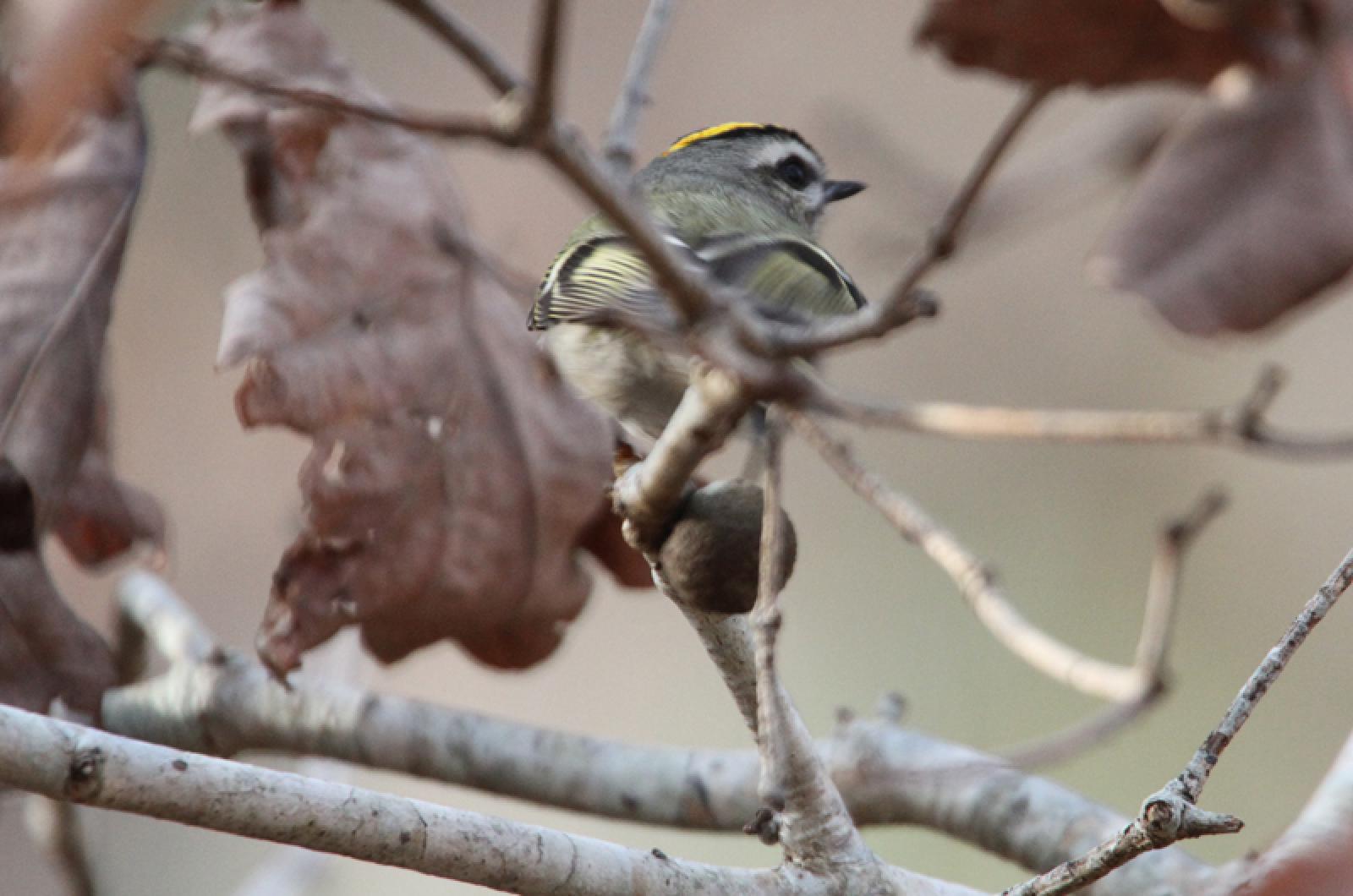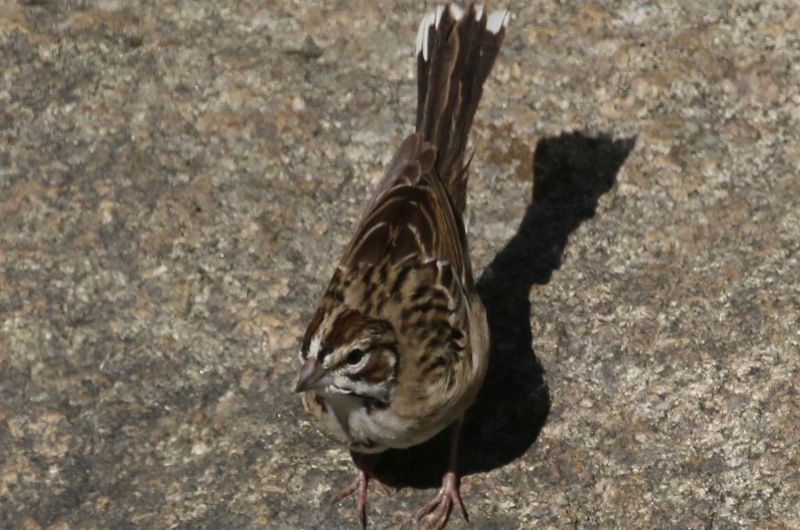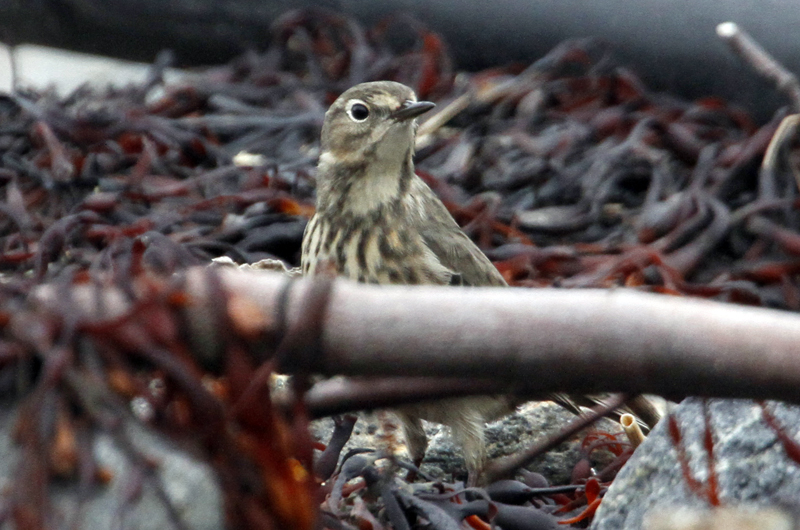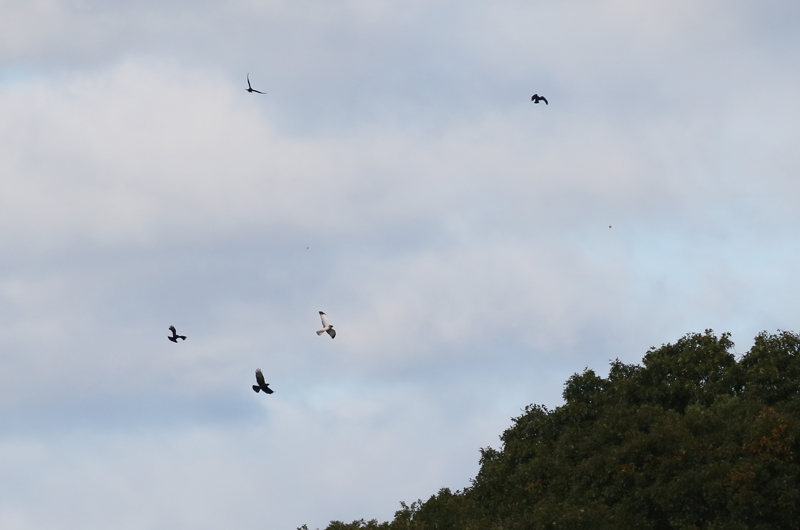A lark sparrow is this week’s Bird of the Week. Soo Whiting was drinking her tea on the morning of Oct. 16 when she noticed an odd sparrow at her feeder. She “slowly reached for her binoculars and took a close look and was thrilled to see a lark sparrow.” This normally western sparrow does not breed east of Illinois, western Kentucky and western Tennessee, and seldom reaches the Atlantic Coast.
Lark sparrows really are pretty easy to identify compared to most sparrows that are often described as “a little brown jobs” and can be rather difficult to identify. Adult lark sparrows generally have a clean white breast with a black spot in the center, reminiscent of the American tree sparrow, which has not yet arrived on its southward migration. The latter has a rusty-brown cap, but the lark sparrow has a distinctive facial pattern with a striped crown, chestnut ear patch and black stripe on the side of its throat.
The bird stayed put, and after a few phone calls Ms. Whiting’s kitchen was full of birders and their cameras with big lenses. The bird was still there the next day.
This is a nice find, and a reminder that we do not always need to go to the Gay Head Cliffs to find rare birds in the fall. Just keep your binoculars nearby.
Bird Sightings
A number of firsts for the year have been reported. Jeff Bernier found the first American pipits of the year, a flock of about 20 of them flying along the shore of Katama Bay on Oct. 16. Another first for the season is Matt Pelikan’s Oct. 12 report of golden-crowned kinglets at his Oak Bluffs home. And Allan Keith spotted six white-throated sparrows for the first time this fall on Oct. 8, in his farm fields along with a flock of 16 killdeer. On Oct. 12 the first white-crowned sparrow of the year was spotted with the white-throateds at the Gay Head Cliffs. And on Oct. 11 in Aquinnah with Bob Shriber, he found one grasshopper sparrow and two Lincoln’s sparrows.
Eastern bluebirds are a favorite species for many birders. Lanny McDowell found a flock of them at Thimble Farm on Oct. 16, Penny Uhlendorf heard quite a few of them on Oct. 15 at the Agricultural Hall, Suzan Bellincampi reports they are at Felix Neck, and my Saturday morning guided birding tour found a flock of about 20 bluebirds in the field that hosts the instrument landing system towers for the airport – easiest access is behind the headquarters of the Manuel Correllus State Forest. As Mr. McDowell points out, we almost always hear bluebirds before we see them, so get to know their “cher-wher” call and their gurgling “cheer cheerily-charlie” song which they sing year-round. It is nice to have so many reports, as I had not seen or heard any for a few months.
Mr. McDowell reports that Thimble Farm also hosted a Wilson’s snipe, an American pipit, multiple palm warblers and chipping sparrows, northern flickers and an acrobatic male northern harrier which defended itself in flight by flipping upside down to present its talons to the marauding American crows.
On Oct. 14 Mr. McDowell found a phoebe that was hawking insects from the back of a cow. They will take advantage of a reliable source of food!
Nathalie Woodruff observed two juvenile black-crowned night-herons at Sheriff’s Meadow Sanctuary in Edgartown on Oct. 13, while Maria Thibodeau observed an adult there the same day.
Mr. Keith has spent quite a bit of time in the field this week. In addition to the above mentioned firsts of the season, at Gay Head on Oct. 11 he saw blue-headed vireo, Philadelphia vireo, red-eyed vireo, both species of kinglets, yellow-breasted chat, indigo bunting and swamp sparrow. The next day at the cliffs he added nine species of warblers: orange-crowned, Nashville, yellow-rumped, pine, western palm, blackpoll, black-throated blue, American redstart and common yellowthroat. Also on Oct. 12 he found more orange-crowned warblers at Squibnocket, bringing his daily total to four — more of these elusive warblers than he has ever seen in one day. Two lesser black-backed gulls, four semipalmated plovers, two western willets, a saltmarsh sparrow, and a late common tern highlighted his Oct. 13 visit to Norton Point Beach. That is a productive few days.
Ken Magnuson found an orange-crowned warbler at the Edgartown Golf Club on Oct. 11. He also found wood duck, blue-winged teal and a yellow–billed cuckoo.
Also on Oct. 11, Mr. McDowell, Ms. Whiting and Flip Harrington found a horned lark in the dunes of Norton Point Beach. It was identified as the northern subspecies — a winter visitor — rather than the prairie subspecies that breeds here. Shortly after that they spotted a dark-eyed junco in the dunes, an unusual location for this species.
Luanne Johnson notes that the red-breasted nuthatches have disappeared as of Oct. 17; they had been in her Oak Bluffs yard for a week or so. Her eastern towhees are also gone, while Charlie Kernick was surprised to find a towhee at his feeder on Oct. 17. Most towhees leave, but some will stay through the winter.
Southbound migrants are passing through in large numbers; please look for them and report your sightings to birds@mvgazette.com.
Robert Culbert leads Saturday morning Guided Birding Tours and is an ecological consultant living in Vineyard Haven.








Comments
Comment policy »